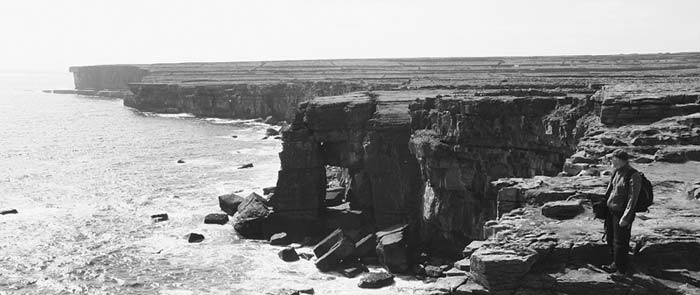
Inishmore • Inisheer
Strewn like limestone chips hammered off the jagged west coast, the three Aran Islands—Inishmore, Inishmaan, and Inisheer—confront the wild Atlantic with stubborn grit. The largest, Inishmore (9 miles by 2 miles), is by far the most populated, interesting, and visited (try to spend a night here). Inisheer, the smallest (1.5 miles square), and best reached from Doolin, is worth considering for travelers with less time.
The landscape of all three islands is harsh. Steep, rugged cliffs fortify the southern flanks of each island. Windswept rocky fields, stitched together by stone walls, blanket the interiors. And the island’s precious few sandy beaches hide in coves that dimple the northern shores. During the winter, severe gales sweep through; because of this, most of the settlements on the islands are found on the more sheltered northeastern side.
There’s a stark beauty about the Aran Islands and the simple lives their inhabitants eke out of a mean sea and less than six inches of topsoil. Precious little of the land is productive. In the past, people made a precarious living here from fishing and farming. The scoured bedrock offered little in the way of soil, so it was created by the islanders—the result of centuries of layering seaweed with limestone sand and animal dung. Fields are small, divided by several thousand miles of “drystone” wall (made without mortar). Most of these are built in the Aran “gap” style, in which spaces between angled upright stones are filled with smaller stones. This allows a farmer who wants to move livestock to dismantle a short section of wall as a temporary opening, and then rebuild that section afterward. It also allows the harsh winter winds to blow through without knocking down the wall. Nowadays, tourism boosts the islands’ economy.
The islands are a Gaeltacht area. While the islanders speak Irish amongst themselves, they happily speak English for their visitors. Many islanders have direct, personal connections with close relatives in America. I once met an Aran minivan driver who served in the US Navy aboard a destroyer before coming back home to Inishmore. Five of his six children now have American passports.
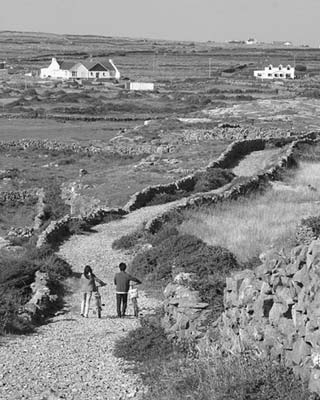
Today, the 800 people of Inishmore (literally “the big island”) greet as many as 2,000 visitors a day. The vast majority of these are day-trippers. They’ll hop on a minivan at the dock for a 2.5-hour visit to Dún Aenghus (the must-see Iron Age fort), grab a simple lunch, and then spend an hour or two browsing through the few shops or sitting at a picnic table outside a pub with a pint of Guinness.
The other islands, Inisheer and Inishmaan, are smaller, much less populated, and less touristy. While extremely quiet, they do have B&Bs, daily flights, and ferry service. For most, the big island is quiet enough. But Inisheer is a good alternative if your travel plans take you to Doolin (a 25-minute ferry ride away) and not Galway, which is closer to Inishmore’s port.
The largest of the Aran Islands has a blockbuster sight: the striking Dún Aenghus fort, set on a sheer cliff. Everyone arrives at Kilronan, the Aran Islands’ biggest town, though it’s just a village. Groups of backpackers wash ashore with the docking of each ferry. Minivans, bike shops, and a few men in pony carts sop up the tourists.
Most travelers visit Inishmore (Inis Mór) as a day trip by boat from Galway. (Boats from Doolin are too slow and weather-dependent to allow enough time for a same-day round-trip to Inishmore.) Here’s a good framework for a day trip: Leave Galway at 9:00 on the shuttle bus to Rossaveel, where you’ll catch the 10:30 boat. You’ll step off the boat in Kilronan at about 11:15. Arrange minivan transport or rent a bike, visit Dún Aenghus, and grab a bite at a café near the base of the Dún Aenghus fort trail. Explore the island during low tide, and depart on the boat when high tides return between 16:00 and 18:00. You can squeeze an extra hour or two out of your day trip by booking an early flight over and a late flight back from Connemara Regional Airport near Rossaveel. For more details on these options, see “Aran Islands Connections” at the end of this chapter.
Staying Overnight: Travelers spending the night can savor the quiet time before and after the day-trip crowds. Here’s how I’d suggest you spend your arrival day: Since most day-trippers make a beeline straight off the boat to Dún Aenghus, head in the opposite direction to check out the subtle charms of the less-visited eastern end of the island. Buy a picnic at the Spar supermarket in Kilronan. Then walk to either the ruins of tiny St. Benen’s Church (an easy 45-minute hike one way from Kilronan, on a ridge just past the Tigh Fitz B&B) or the rugged Black Fort ruins (a rocky 1-hour scramble one way from Kilronan). Save Dún Aenghus for later in the afternoon, after the midday crowds have subsided (allow an hour at Dún Aenghus, closes at 18:00 March-Oct, off-season at 16:00, last entry one hour before closing). Enjoy an evening in the pubs and take a no-rush midmorning boat trip back to the mainland the next day.
Your first stop on Inishmore is the town of Kilronan, huddling around the pier. There are about a dozen shops and B&Bs, about half as many restaurants, and a couple of bike-rental huts (regular bikes-about €10/day plus €10 deposit, snazzy new electric bikes-€25/day plus €20 deposit).
A few blocks inland up the high road, you’ll find the best folk-music pub (Joe Watty’s), a post office (Mon-Fri 9:00-13:00 & 14:00-17:30, Sat 9:00-13:00, closed Sun), and a tiny bank across from the roofless Anglican church ruins (open only on Wed 10:00-12:30 & 13:30-15:00, plus Thu June-Aug). A friendly Internet café lurks behind the stony Aran Sweater Market building, across from the high cross (May-Sept daily 10:00-20:00, shorter hours in winter, €1/10 minutes, €5/hour, also shows Man of Aran film described later, under “Sights on Inishmore”).
The huge Spar supermarket, two blocks inland from the harbor, seems too big for the tiny community and has the island’s only ATM. If you don’t have plenty of cash on you, get some here—most B&Bs and quite a few other businesses don’t accept credit cards.
Kilronan’s TI is helpful, but don’t rely on it for accommodations; the B&B owners who work with the TI are out of town and desperate (daily 10:00-17:00, July-Aug until 18:00, shorter hours in winter, faces the harbor, tel. 099/61263).
The TI offers free maps of the island (though your ferry operator may have already given you one). This map is all the average day-tripper or leisure biker will need to navigate. But serious hikers who plan on scampering out to the island’s craggy fringes will want to invest in the detailed black-and-white Oileáin Árann map and companion book by Tim Robinson (€16, sold at the Internet café behind the Aran Sweater Market, and at some bookstores in Galway).
Public WCs are 100 yards beyond the TI on the harbor road.
Just about anything on wheels functions as a taxi here. A trip from Kilronan to Dún Aenghus to the Seven Churches and back to Kilronan costs €10 per person in a shared minivan. Pony carts cost about €40 for two people (€75 for 4) for a trip to Dún Aenghus and back.
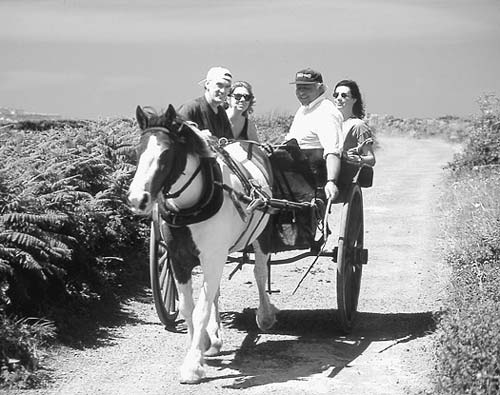
Biking is great, although the terrain is hilly and there are occasional headwinds and unpredictable showers (figure 30 minutes to ride from Kilronan to start of trailhead up to Dún Aenghus). Cyclists should take the high road over and the low road back—fewer hills, scenic shoreline, and at low tide, a dozen seals basking in the sun. Keep a sharp lookout along the roads for handy, modern limestone signposts (with distances in kilometers) that point the way to important sights. They’re in Irish, but you’ll be clued in by the small metal depictions of the sights embedded within them.
Fewer than 100 vehicles roam the island, and most of them seem to be minivans. A line of vans (which seat 8-18 passengers) awaits the arrival of each ferry, offering €10 island tours. They’re basically a shared taxi service that will take you to the various sights, drop you off, and return at an agreed time to take you to the next attraction.
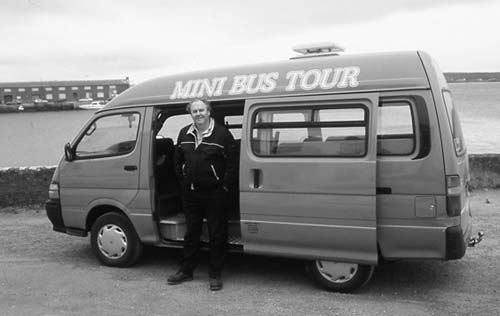
Chat with a few drivers to find one who likes to talk. On my tour, I learned that 800 islanders live in 14 villages, with three elementary schools and three churches. Most islanders own a small detached field where they keep a couple of cows (sheep are too much trouble). When pressed for more information, my guide explained that there are 400 different flowers and 19 different types of bees on the island. Then he pointed to the 2000-year-old ring fort on the hilltop and grinned, saying, “It’s so popular with visitors that we plan to build another 2000-year-old ring fort next year.”
The tour, a convenient time-saver, zips you to the end of the island for a quick stroll in the desolate fields, gives you 10 minutes to wander through the historic but visually unimpressive Seven Churches, and then drops you off for two hours at Dún Aenghus (30 minutes to hike up, 30 minutes at the fort, 20-minute hike back down, 40 minutes in café for lunch or shopping at drop-off point) before running you back to Kilronan. These sights can be linked together in various sequences, but the trailhead crossroads below Dún Aenghus—with its two simple cafés—makes the best lunch stop. Ask your driver to take you back along the smaller coastal road (scenic beaches and sunbathing seals at low tide).
This Oscar-winning 1934 movie (1.25 hours) is a documentary about traditional island life with an all-local cast. It’s basically a silent movie with the sounds of surf, seagull, and sailor (muttering in barely audible Irish) dubbed in. Yet it’s a strangely fascinating glimpse of the past and was groundbreaking in its time. The movie tries to re-create life in the early 1900s—when you couldn’t rent bikes—and features currachs (canoe-like boats) in a storm, shark fishing with handheld harpoons, and farmers cultivating the fields from bare rock.
Cost and Hours: €5, 3 showings/day—usually on request, plays in Internet café behind Aran Sweater Market—see here for hours.
This is the island’s blockbuster sight. The stone fortress hangs spectacularly and precariously on the edge of a cliff 200 feet above the Atlantic. The crashing waves seem to say, “You’ve come to the end of the world.” Gaze out to sea and consider this: Off this coast, Hy Brasil—a phantom island cloaked in mist—was said to pop into view once every seven years. This mythical place appeared on maps as late as the mid-1600s.
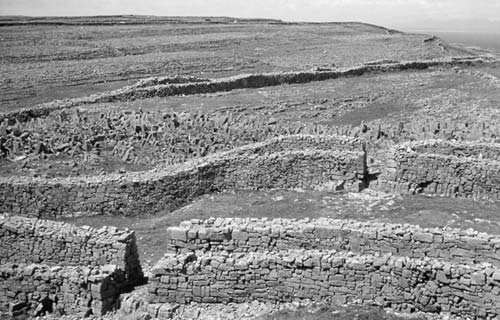
Little is known about this 2,000-year-old Celtic fort. Its concentric walls are 13 feet thick and 10 feet high. As an added defense, the fort is ringed with a commotion of spiky stones, sticking up like lances, called a chevaux-de-frise (literally, “Frisian horses,” named for the Frisian soldiers who used pikes to stop charging cavalry). Slowly, as the cliff erodes, hunks of the fort fall into the sea.
Cost and Hours: €3, daily March-Oct 9:00-18:00, Nov-Feb 10:00-16:00, last entry one hour before closing, from June-Aug guides at the trailhead answer questions and can sometimes give free tours up at the fort if you call ahead, 5.5 miles from Kilronan, tel. 099/61008.
Visiting the Fort: Dún Aenghus doesn’t get crowded until after 11:00. I enjoyed a half-hour completely alone at 10:00 in the tourist season; if you can, get there early or late. A small museum (housing the ticket office and controlling access to the trail) displays aerial views of the fort and tells the story of its inhabitants. Advice from rangers: Wear sturdy walking shoes and watch your kids closely; there’s no fence between you and a crumbling 200-foot cliff overlooking the sea.
Close to the western tip of the island, this gathering of ruined chapels, monastic houses, and fragments of a high cross dates from the 8th to 11th century. The island is dotted with reminders that Christianity was brought to the islands in the fifth century by St. Enda, who established a monastery here. Many great monks studied under Enda. Among these “Irish apostles” who started Ireland’s “Age of Saints and Scholars” (A.D. 500-900) was Columba (Colmcille in Irish), the founder of a monastery on the island of Iona in Scotland—home of the Irish monks who produced the Book of Kells. Check out the ornate gravestones (best detail on sunny days) of the “seven Romans,” located in the slightly elevated back corner of the graveyard, farthest from the road. These pilgrims came here from Rome in the ninth century, long after the fall of the Roman Empire.
The island’s second village sits below Dún Aenghus. With a gaggle of homes, a B&B, a great sheltered swimming beach, and a pub, this is the place for peaceful solitude. This narrowest section of the island also has the best grazing land, a fact not lost on the local landlord who claimed it for himself.
The quiet eastern end of Inishmore offers ancient sites in evocative settings for overnight visitors with more time, or for those seeking rocky hikes devoid of crowds. First, get a good hiking map from the Kilronan TI. Then consider assembling a picnic, to fuel up either before or after you spend a couple of hours exploring these sights on foot. Ask the folks in town for directions (almost always a memorable experience in Ireland).
Closest to the road, amid the dunes one mile past the Tigh Fitz B&B and just south of the airport, is the eighth-century St. Enda’s Church (Teaghlach Einne). Protected from wave erosion by a stubborn breakwater, it sits half-submerged in a sandy graveyard, surrounded by a sea of sawgrass and peppered with tombstones. St. Enda is said to be buried here, along with 125 other saints who flocked to Inishmore in the fifth century to learn from him.
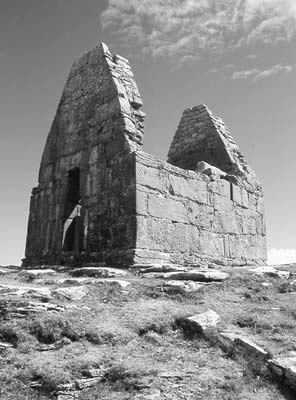
St. Benen’s Church (Teampall Bheanáin) perches high on a desolate ridge opposite the Tigh Fitz B&B. Walk up the stone-walled lane, passing a holy well and the stubby remains of a round tower. Then take another visual fix on the church’s silhouette on the horizon, and zigzag up the stone terraces to the top. The 20-minute hike up from the B&B pays off with a great view. Dedicated to St. Benen, a young disciple of St. Patrick himself, this tiny (12 foot by 6 foot) 10th-century oratory is aligned north-south (instead of the usual east-west) to protect the doorway from prevailing winds.
About a five-minute walk past the Tigh Fitz B&B (heading toward the airport), you’ll notice an abandoned stone pier and an adjacent, modest medieval ruin. This was Arkin Fort, built by Cromwell’s soldiers in 1652 using cut stones taken from the round tower and the monastic ruins that once stood below St. Benen’s Church. The fort was used as a prison for outlawed priests before they were sent by English authorities to the West Indies to be sold into slavery.
Hidden on a remote, ragged headland an hour’s walk from Kilronan to the south side of the island, you’ll find the Black Fort (Dún Duchathair). After Dún Aenghus, this is Inishmore’s most dramatic fortification. A good map is essential to navigate here. Built on a promontory with cliffs on three sides, its defenders would have held out behind drystone ramparts, facing the island’s interior attackers. Watch your step on the uneven ground, be ready to course-correct as you go, and chances are you’ll have this windswept ruin all to yourself.
Kilronan’s pubs offer music sporadically on summer nights. Nothing is dependably scheduled, so ask at your B&B or look for posted notices on the front of the Spar supermarket or post office. Joe Watty’s Pub, on the high road 100 yards past the post office, is your best bet, with good Irish folk music tentatively set for Wednesdays and weekends. The more central Joe Mac’s Pub (next to the hostel) and the American Bar (next to the high cross at the base of the high road) are also possibilities.
The Halla Ronain community center becomes a dance hall on a few Saturday nights, when from midnight to 2:00 in the morning, locals have a ceilidh (KAY-lee), the Irish equivalent of a hoedown. Ask at the TI to see if one is scheduled during your stay.
Remember, this is a poor island. Most rooms are plain, with sparse plumbing. Only the Pier House takes credit cards—all my other listings are cash only.
$$$ The Pier House stands solidly, 50 yards from the pier, offering 12 decent rooms, a good restaurant downstairs, and sea views from many of its rooms (Db-€70-100, Wi-Fi, tel. 099/61417, www.pierhousearan.com, pierhousearan@gmail.com).
$$ Clai Ban, the only really cheery place in town, has six rooms and is worth the 10-minute uphill walk from the pier. The Hernon youngsters are avid traditional musicians. The place is patrolled by their friendly and pudgy Corgi, Guinness (Sb-€50-70, Db-€60-70, Tb-€90-105, walk past bank out of town and down lane on left, tel. 099/61111, claibanhouse@gmail.com, Marion and Bartley Hernon).
$$ Tigh Catherine is a well-kept B&B with four homey rooms overlooking the harbor (Sb-€45-50, Db-€70, Tb-€90, on Church Road up behind the Halla Ronain community center, tel. 099/61464, mobile 087-980-9748, catherineandstiofain@gmail.com, Catherine Mulkerrin).
$$ Seacrest B&B offers six uncluttered rooms in a central location next to the Aran Fisherman restaurant (Sb-€45-50, Db-€70, Tb-€90, Wi-Fi, tel. 099/61292, mobile 087-161-6507, seacrestaran@gmail.com, Geraldine and Tom Faherty).
$ Kilronan Hostel, overlooking the harbor near the TI, is cheap but noisy above Joe Mac’s Pub (€18-25 beds in 4- to 6-bed rooms, guest computer, free Wi-Fi, self-service kitchen, tel. 099/61255, www.kilronanhostel.com, kilronanhostel@gmail.com).
$$$ Man of Aran B&B, as classy as a thatched cottage can be, is in the peaceful countryside four miles outside of touristy Kilronan, toward the western end of the island. Rooms are quiet and rustic, with fireplaces. The restaurant serves €22-25 meals (with homegrown vegetables and herbs) only to overnight guests. The setting is pristine—this is where the movie of the same name was filmed 80 years ago (S-€55, Sb-€60, D-€80, Db-€90, reserve well in advance, closed Nov-Feb; 4 miles/6.5 km from Kilronan, bear right 100 yards after passing Kilmurvey Beach before Dún Aenghus turnoff; tel. 099/61301, www.manofarancottage.com, manofaran@eircom.net, Maura and Joe Wolf).
There are few restaurants in Kilronan and none are fancy. Plan on comfort food at reasonable prices.
The Pier House operates the dependable Bia Restaurant on the ground floor of its guesthouse (€12-18 lunches, €18-25 dinners, daily 11:00-22:00, tel. 099/61811).
Otherwise, Kilronan’s modest cafés dish up hearty soup, soda bread, sandwiches, and tea.
Sean Cheibh (“Old Pier”), which seems to slam out more meals than the rest of the town combined, is popular for its fish-and-chips and great clam chowder (eat in or take out, April-mid-Oct daily 11:00-19:00, closed mid-Oct-March, tel. 099/61228).
Supermarket: The Spar has all the groceries you’ll need (June-Aug Mon-Sat 9:00-20:00, Sun 10:00-17:00; Sept-May Mon-Sat 9:00-18:00, closed Sun).
The roughly circular little island of Inisheer (Inis Oir) has only a quarter of the land area and population of Inishmore—my island of choice. But Inisheer’s close proximity to the mainland makes it an easy 25-minute boat journey from Doolin and a good option for those with limited time who aren’t going north to Galway (closer to Inishmore’s port at Rossaveel).
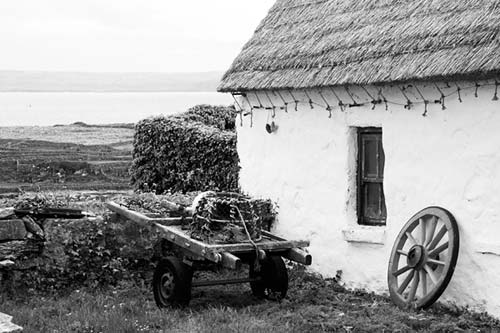
Inisheer offers a vivid glimpse of Aran Island culture and has an engaging smorgasbord of sights. For some reason, this quaint little island seems to attract as many German-speaking visitors as English-speaking ones.
Take an early boat from Doolin to maximize your time on Inisheer. For more details, see “Aran Islands Connections” at the end of this chapter.
You’ll dock on the north side of the island in its only settlement. Facing inland with your back to the pier, you’ll be able to see nearly all of the island’s landmarks (except for the An Plassy shipwreck and the lighthouse on the southern shore). Although a handful of pony carts and minivan drivers meet you at the pier, I’d rely on them only on a rainy day (€10, but prices are soft...negotiate).
For me, the joy of compact Inisheer is seeing it on a bike ride or a long breezy walk. The bike rental outfit is right at the base of the pier (€10/day, no deposit necessary “unless you look suspicious”). Any of the boat operators in Doolin can give you a free map of the island showing Inisheer’s primitive road network. That’s all you’ll need to navigate.
There are three pubs on the island, one small grocery store (see “Eating on Inisheer,” later), and no ATMs. All of the sights, with the exception of the lonely lighthouse on the southern coast, are concentrated on the northern half of an already small island.
Inisheer lacks the dramatic (and much higher) coastal cliffs of Inishmore, but has its own unique photogenic charms. Fans of the 1990s British sitcom Father Ted may recognize parts of the island, which were featured in the show’s intro depicting its fictional Craggy Island location.
The sights described below are free, open all the time, and marked on your free boat company map. See them in the order listed, from west to east, across the northern half of the island. If you bike rather than hike, be prepared to walk the bike up (or down) short, steep hills.
The ruins of this castle dominate the hilltop and are visible from almost anywhere on the northern half of the island. It’s a steep 20-minute walk from the pier up to the castle ruins. The small castle was built as a tower house refuge around 1400 by the O’Brien clan from nearby County Clare. It sits inside a low wall of a much older Iron Age ring fort. Cromwell’s troops attacked the castle in 1652, leaving the evocative ruins you see today.
If you’ve huffed your way up to O’Brien’s Castle, then go another easy five minutes to the Napoleonic Tower (An Tur Faire), which was built in the early 1800s to watch for a feared French invasion that never took place. The views from this highest point on the island are worth it.
• Consult your map and continue walking (south) on the paved road into the heart of the island. Take your first right turn, roughly 100 yards after the Napoleonic Tower, onto a rocky, grassy cow lane that zigzags downhill into a lush hidden valley, displaying the prettiest mosaic of ivy-tangled rock walls and small green fields I’ve seen anywhere on the Aran Islands. Unholster your camera and fire away.
Once you’ve wound your way back down to the main north-shore road again, turn right and continue east with the airstrip on your left. On your right, you’ll soon see a time-passed graveyard up atop a sandy hill. Hike the 50 yards up into the graveyard to find...
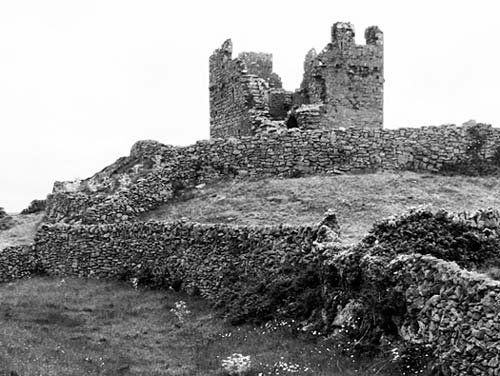
St. Cavan was the brother of St. Kevin, who founded the monastery at Glendalough in the Wicklow Mountains (see here). In the middle of the graveyard is a sunken sandpit holding the rugged roofless remains of an 11th-century church. The shifting sand dunes almost buried it before sawgrass stabilized the hill. St. Cavan’s reputed gravesite is protected by a tiny modern structure worth poking your head into for its candlelit atmosphere. Local folklore held that if you spent a night sleeping on the tomb lid, your particular illness would be cured.
• Walk back down to the north-shore road and head out on the coast road (to the southeast) 30 minutes to the remote...
This freighter was wrecked offshore on Finn’s Rock in 1960. But islanders worked with the coastal patrol to help rescue the crew with no loss of life. A couple of weeks later the unmanned ship was washed high up onto the rocky shore, where it still sits today, a rusty but fairly intact ghost ship with a broken back. Beware of turning an ankle on the unstable footing of the rounded cobbles thrown up by the surf near the wreck.
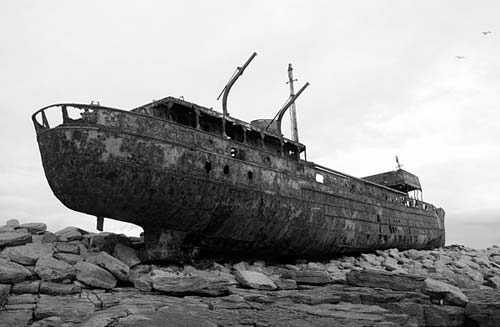
• With more time, consult your map and seek out the remaining intimate little church ruins and holy wells that the island has to offer. Or head back to town for a beverage while you await the return ferry.
A scattering of B&Bs dots the northern half of the island. Here are two good options:
$$ South Aran House is a quiet, well-run place with five spic-and-span, black-and-white rooms. Friendly Enda and Maria Conneely are generous with local tips and also run the nearby Fisherman’s Cottage restaurant, where you’ll have breakfast (Sb-€45-55, Db-€70-90, an easy 10-minute walk west of pier on north-shore road, call ahead with your ferry arrival time so they can meet you with keys, tel. 099/75073, mobile 087-340-5687, www.southaran.com, info@southaran.com).
$ Bru Hostel is a simple, economical, 40-bed option just 100 yards west of the pier, next to Tigh Ned Pub (€20 dorm beds, includes continental breakfast, tel. 099/75024, radharcnamara@hotmail.com).
Inisheer’s three main pubs offer decent pub grub (usually 12:30-20:30). Tigh Raurai Pub (House of Rory) is the epicenter of island social life (from the pier, head east to the edge of the beach and turn right—inland—up a narrow lane for 100 yards). Just below it, closer to the beach, is Ostan Inis Oirr Pub (Hotel Inisheer) with a colorful collage of international flags draping the pub’s ceiling. Tigh Ned Pub (House of Ned) is right next door to Bru Hostel, near the pier on the north-shore road. Life could be worse than to sit outside at their appealing front tables on a summer evening, enjoying a pint in the salt air.
For a mellow evening meal, try the Fisherman’s Cottage, a five-minute walk west of the pier on the north-shore road (daily 12:00-15:00 & 19:00-21:00, tel. 099/75073, mobile 087-340-5687).
Picnic lovers flock to the island’s small grocery, Siopa XL, behind Ostan Inis Oirr Pub and below Tigh Raurai Pub (Mon-Sat 9:00-17:00, Sun 10:00-15:00).
For an overview map of the region, see here.
Island Ferries sails to Inishmore from Rossaveel, a port 20 miles west of Galway. The company sells tickets at the Galway TI and runs a 45-minute shuttle bus from Galway to the Rossaveel dock (3/day April-Oct, 2/day Nov-March, 45-minute crossing; coming from Galway, allow 2 hours in transit one-way including 45-minute bus ride; €25 round-trip boat crossing plus €7 round-trip for Galway-Rossaveel shuttle bus, 10 percent discount if you book online, WCs on board). Catch shuttle buses from Galway on Queen Street, a block behind the Kinlay Hostel (check-in 1.5 hours before sailing); shuttles return to Galway immediately after each boat arrives. Ferry schedule for April-Oct: from Rossaveel at 10:30, 13:00, and 18:30; from Inishmore at 8:15, 12:00, 16:00, and 17:00 (plus 18:30 July-Aug). Island Ferries has two offices in Galway: on Forster Street across from the TI and across from Kinlay Hostel on Merchants Road (tel. 091/568-903, after-hours tel. 091/572-273, www.aranislandferries.com).
Beware: The boat you take out to the islands may not be the same as the one you come back on. And sometimes you’ll board by walking up the gangplank of one boat and walking across its deck to another boat docked beside or behind it. Make sure to ask.
Drivers should go straight to the ferry landing in Rossaveel, passing several ticket agencies and pay parking lots. At the boat dock, you’ll find a convenient €5-per-day lot and a small office that sells tickets for Island Ferries. Check to see what’s going when and for how much.
Boats from Doolin to the Aran Islands can be handy, but they are often canceled or run late. Even a balmy day can be too windy (or the tide can be too low) to allow for a sailing from Doolin’s crude little port. There are plans to build a new pier, which will make sailing schedules more dependable.
While it’s possible to travel from Doolin to Inishmore and back in one day, keep in mind that it’s a longer trip to distant Inishmore than the other two Aran Islands (leaving less time ashore to explore before you have to turn around and sail back to Doolin). Instead, consider an overnight stay on Inishmore, or opt for a day trip to nearby, though less spectacular, Inisheer.
Parking is free beside the Doolin pier, even overnight. If you have a car, Doolin is easy to reach; without one, it’s better to get to Inishmore from Rossaveel (described earlier).
The scene at the Doolin ferry dock is a confusing mosh pit of competition. Two ferry companies operate from three ticket huts with one thing in mind: snaring your business. They have similar schedules and might honor the other’s return tickets (if you decide you want to return at a different time). Note that the wind and tides can cause cancellations on any Aran ferries sailing from Doolin. The larger boats sailing from Rossaveel (farther north, 45 minutes west of Galway) are less weather-dependent. Prices can vary with the intensity of the competition. Although they may promise to get you to Inishmore in an hour, every one of my trips in the past few years has included brief stops at Inisheer and Inishmaan en route, making the actual crossing time about 1.5 hours.
Doolin2Aran Ferries is run by friendly Donie Garrihy and his family (to Inishmore: €20 round-trip, 2/day, 1.5 hours, departs at 10:00 and 13:00, returns at 11:30 and 16:00; to Inisheer: €15 same-day round-trip, 4/day, 30 minutes, departs at 10:00, 11:00, 13:00, and 17:30, returns at 8:15, 11:15, 14:00, and 16:45). They also offer a fun €25 triangular day trip that takes you from Doolin to Inisheer, drops you off on Inisheer for about four hours, then returns to Doolin along the base of the Cliffs of Moher (departs at 9:00, has you back in Doolin by 16:00, runs April-Oct, tel. 065/707-5949, mobile 087-245-3239, www.doolin2aranferries.com).
O’Brien Line, run by Bill O’Brien, has been at it the longest, with similar schedules and prices. They too offer a cruise along the base of the Cliffs of Moher that includes a stop at Inisheer (tel. 065/707-5555, www.obrienline.com).
No matter which company you choose, it’s smart to check online for discounts, and call a day or two ahead to confirm schedules and prices.
Aer Arann Islands, a friendly and flexible little airline, flies daily from Connemara Regional Airport, stopping at all three islands (3/day, up to 11/day in peak season, €23 one-way (when boating back), €45 round-trip, groups of 4 or more pay €40 each, 10-minute flight, tel. 091/593-034, www.aerarannislands.ie, aerarann@iol.ie). These eight-seat planes get booked up—reserve two or three days in advance with a credit card. Connemara Regional Airport is 20 slow miles west of Galway—allow 45 minutes for the drive, plus 30 minutes to check in before the scheduled departure. A minibus shuttle—€3 one-way—runs from Victoria Hotel off Eyre Square in Galway an hour before each flight. Be sure to reserve a space on the shuttle bus at the same time you book your flight. The Kilronan airport on Inishmore is minuscule. A minibus shuttle travels the two miles between the airport and Kilronan (buses stop at Aran Fisherman restaurant) and costs €5 round-trip.
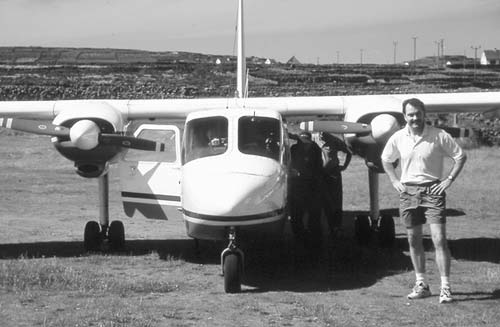
In July and August, a sightseeing-only Aer Arann flight leaves from the same airport at 12:00 each day. You’ll fly above all three Aran Islands with an extra swoop past the Cliffs of Moher (€55, 30 minutes, may not go if not enough people sign up).